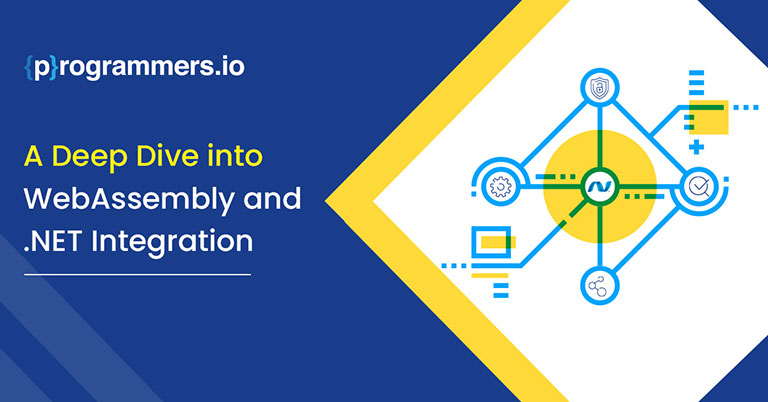Like any other field, web development has its own set of challenges, including browser compatibility, performance, and speed. Different development practices and tools have tried to address these problems in their own way, but considering the immensity of the Internet and the World Wide Web, it’s only natural that there are multiple ecosystems with their native development, data management, and programming environments and standards.
Web applications that can thrive in any ecosystem are a goal the development community is striving to achieve, and WebAssembly (or Wasm) can be considered a major “leap” in this regard. It’s a binary instruction format that can serve as a portable compilation target for high-level languages like C++, C#, and Rust, allowing them to create web applications that can perform at a near-native speed. It became a W3 recommendation in 2019.
In addition to their fundamental strengths, mergers like WebAssembly .NET can lead to exciting new possibilities in the world of web development.
WebAssembly .NET
Even though Javascript continues to dominate the web development scene, we may see it expanding with powerful combinations like WebAssembly and .NET, especially when it comes to performance-critical web applications.
Blazor
WebAssembly and .NET can be combined in various ways and technologies, the most prominent of which is perhaps Blazor. Developed by Microsoft, Blazor is a framework that serves as an alternative to JavaScript, particularly in the front end. It allows web developers to use C# and the broader .NET framework to create front-end applications. While C# is a language of choice for the backend for many developers, Blazor allows its use for developing the front end as well. Language uniformity yields benefits like easier code management and performance. There are fewer runtime errors, and bits of code can be reused on both the client and server side.
However, Blazor would not have existed if it weren’t for WebAssembly, which allows the C# code and applications developed on .NET to be translated for any browser. Blazor is one of the ways the powerful WebAssembly .NET combination works, providing developers with a more performance-oriented alternative to JavaScript.
But it’s important to keep in mind that it’s an alternative, not a replacement of JavaScript, and allows for developers from a different tech stack (C#, .NET framework, ASP.NET Core, etc.) to develop web applications or broaden the arsenal of full stack developers that have expertise in both .NET and JavaScript, so they can choose the right option for applications where Web Performance is an important priority.
Other WebAssembly .NET Combinations
Blazor is by far the most prominent example of WebAssembly and .NET framework working in conjunction, but it’s not the only one. WASM.NET allows developers to use some of the most common .NET languages like C# and F# to leverage the power of WebAssembly directly, without another framework like Blazor acting as an intermediary. Since WASM.NET is essentially a set of libraries facilitating direct WebAssembly access, it’s language-agnostic (it can translate any .NET language into WebAssembly modules) and far more flexible than a framework like Blazor while offering more comprehensive control over resources and APIs.
Another way WebAssembly and .NET combine is Uno Platform, a framework that allows for the development of applications that leverage device native resources for web app User Interface. It facilitates .NET interop via WebAssembly.
How are WebAssembly and .NET together Revolutionizing web development?
There are several ways the WebAssembly .NET combo contributes to the constant evolution and growth of the realm of web development. The most prominent ones are:
Performance
It wouldn’t be a stretch to say that WebAssembly has expanded the horizon of the performance of web applications. If we add .NET’s development strengths to the equation, like code reusability for front-end and backend, type safety, and an extensive ecosystem, it can significantly magnify the performance benefit. Also, since WebAssembly can run a complete compiled .NET code at once (which can also be tweaked for more efficient resource/hardware use), it can be significantly faster than interpreted Javascript. It’s worth noting that while WebAssembly Modules can be fine-tuned for efficient native hardware use, it does add a level of complexity to the development.
Developer Accessibility
The combination of webAssembly and .NET has contributed to the expansion of the web developer pool as many developers with expertise in desktop applications or other device-native applications can leverage these expertise and strengths to web development. Even developers well-versed in web-specific frameworks like ASP.NET Core can leverage WebAssembly for its high performance and enhanced cross-platform capabilities.
Safety
WebAssembly allows web applications to be deployed in a sandbox environment, which adds another layer of safety and makes it difficult for malicious code to impact the web application code.
Newer “Breeds” of Web Applications
WebAssembly .NET combination has the potential to trigger new breeds of web applications that may not have been possible with JavaScript alone or would be too resource-intensive or needlessly complex in that ecosystem. The offline capabilities and hardware control this combo offers may lead to significant enhancements to applications that use technologies like Augmented Reality (using device hardware). One example would be Single-Page Applications (SPAs). While WebAssembly and .NET combo is not the only way to make Single-page applications (SPAs), it offers characteristic strengths like high performance and security.
Leveraging The Power of Native Hardware
Applications developed using the .NET framework and leveraging the power of WebAssembly might allow developers to shift some of the burden from cloud/online resources to the hardware/device they are being used on. This may allow users to experience better performance of the web applications even when the internet connection is not strong. It may also be possible to serve different slices/versions of a web application based on the hardware that would be used to run the web application. It allows for granular control over which components of a web app can be offloaded to the device and which would consume cloud resources and bandwidth.
Conclusion
WebAssembly future, of which .NET is just one chapter, seems to be quite bright. It compliments a wide range of technologies and development frameworks (like .NET) and can significantly push the boundaries of the scope of functionalities and performance of the web application.




